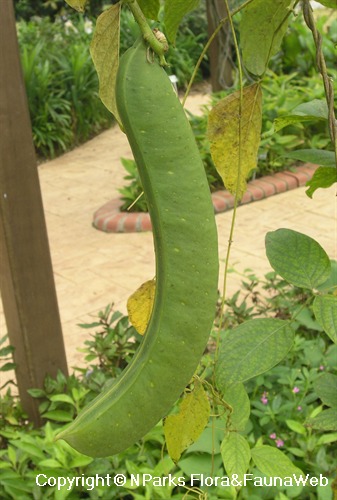.jpg)
Back
Canavalia gladiata (Jacq.) DC.
| Family Name: | Fabaceae (Leguminosae) |
| Synonyms: | Canavalia foureiri, Canavalia gladiolata, Canavalia incurva, Canavalia loureirii, Canavalia machaeroides, Canavalia maxima, Canavalia plagiosperma |
| Common Name: | Sword Bean, 刀豆 |
Name
Classifications and Characteristics
| Plant Division | Angiosperms (Flowering Seed Plants) (Dicotyledon) |
|---|---|
| Plant Growth Form | Climber |
| Lifespan (in Singapore) | Perennial |
| Mode of Nutrition | Autotrophic |
Biogeography
| Native Distribution | Indian Subcontinent, China, Japan, Taiwan, Laos to Vietnam, Panama |
|---|---|
| Native Habitat | Terrestrial |
| Preferred Climate Zone | Tropical, Sub-Tropical / Monsoonal |
| Local Conservation Status | Non-native |
Description and Ethnobotany
| Growth Form | It is a climbing herbaceous plant that can grow up to 10 m long under optimal condition. |
|---|---|
| Stems | Its compound leaves have 3 ovate leaflets. |
| Flowers | Its inflorescence is a raceme, consisting of 10 -20 flowers which are white or light purple. The individual flower measures about 3 cm long. |
| Fruit | Its fruit are pods, sword-shaped, and grow about 20 - 35 cm long and 3 - 6 cm wide. Each pod contains many reddish seeds. |
| Cultivation | Sword bean is cultivated widely in South and Southeast Asia, spread throughout the humid tropics, grown mainly for local consumption. It prefers full sun and humid environment. It is tolerant of some shade and wide range of rainfall conditions. |
| Ethnobotanical Uses | Edible Plant Parts : Edible Seeds Food (Fruit or Vegetable): Young leaves, pods and stems can be eaten fresh, steamed or boiled. Mature or dried seeds (sword beans) contain toxic protein, hence they are usually boiled in two or three changes of water, and the tough seed coats are removed. They are considered an essential food for pregnant women in India. Medicinal: Researches found out that the sword beans have antioxidant properties. |
Landscaping Features
| Desirable Plant Features | Ornamental Fruits |
|---|---|
| Landscape Uses | General, Parks & Gardens |
| Thematic Landscaping | Economic Garden |
| Usage Hazard - Cons | Toxic Upon Ingestion |
Fauna, Pollination and Dispersal
| Pollination Method(s) | Biotic (Fauna) |
|---|
Plant Care and Propagation
| Light Preference | Full Sun, Semi-Shade |
|---|---|
| Water Preference | Moderate Water |
| Plant Growth Rate | Fast |
| Rootzone Tolerance | Well-Drained Soils, Fertile Loamy Soils |
| Maintenance Requirements | Moderate |
| Propagation Method | Seed |
Foliar
| Mature Foliage Colour(s) | Green |
|---|---|
| Mature Foliage Texture(s) | Papery |
| Foliar Type | Compound (Trifoliate) |
Floral (Angiosperm)
| Flower Colour(s) | Purple, White |
|---|---|
| Flower Grouping | Cluster / Inflorescence |
Fruit, Seed and Spore
| Mature Fruit Colour(s) | Green |
|---|---|
| Fruit Type | Fleshy Fruit |
| Mature Seed Colour(s) | Red |
Image Repository
Others
| Master ID | 30531 |
|---|---|
| Species ID | 5203 |
| Flora Disclaimer | The information in this website has been compiled from reliable sources, such as reference works on medicinal plants. It is not a substitute for medical advice or treatment and NParks does not purport to provide any medical advice. Readers should always consult his/her physician before using or consuming a plant for medicinal purposes. |


_lowres.jpg)
_lowres.jpg)
_lowres.jpg)
_lowres.jpg)
_lowres.jpg)
_lowres.jpg)
_lowres.jpg)
